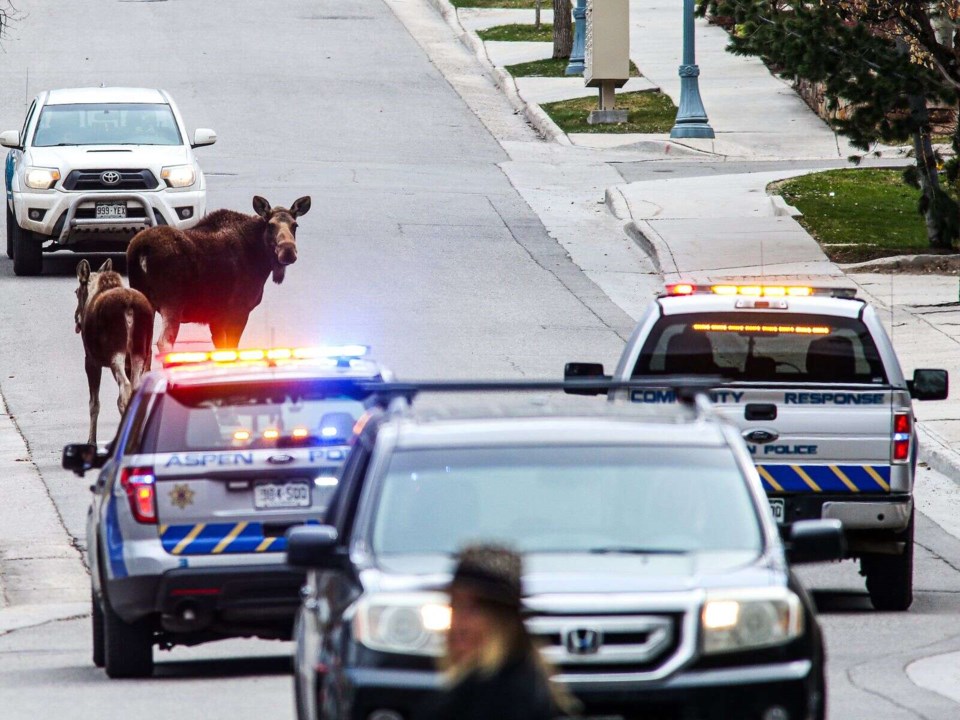Editor’s note: This story was originally published by The Aspen Times and was shared via AP StoryShare.
As the snow melts and spring comes out of its shell in the upper Roaring Fork Valley, human conflicts with bears, moose and mountain lions are increasing.
Local wildlife officials have been fielding calls about bears — they’ve gotten into cars so far though no home break-ins have yet been reported — while moose have already been chased out of the downtown core and at least one dog has been snatched from a yard by a mountain lion, according to wildlife officials.
“Beginning in April, we started to see some (bear) calls, and it’s starting to pickup this month,” Ginna Gordon, an Aspen police officer in charge of bear problems, said Wednesday. “Right now, it’s mainly been sightings.”
Aspen police have fielded 17 bear calls since the beginning of April, while the Pitkin County Sheriff’s Office has responded to four calls in the same time period, said Gordon and ReRe Baker, the county’s animal control deputy.
Most bear calls in the city have come on the east side and in the downtown core, Gordon said. Some have involved bears attempting to break into trash containers, though they have not yet been successful, she said, which is a positive because it shows residents are locking up their trash.
Matt Yamashita, Colorado Parks and Wildlife’s area wildlife manager for the Roaring Fork Valley, said he’s received calls about bears getting into cars so far, but nothing about bears in houses.
“That’s something we know is coming,” Yamashita said Wednesday. “We will have occupied buildings where bears get into them.”
The extent to which bears appear in Aspen neighborhoods and the downtown core during summer is often dependent on the development of natural food sources like grasses, berries and acorns. If a late spring or early summer freeze occurs – a possibility through late June – berry blossoms could be destroyed, while dry summers spawn few acorns. In lean years, bears will come looking for food elsewhere, like the city of Aspen, which leads to increased conflicts with humans, Yamashita said.
That situation occurred in Aspen in the summer and early fall of 2017, and culminated in video-mad tourists chasing a mother and her cubs up a tree on the Hyman Avenue pedestrian mall. They had to be tranquilized and relocated.
It’s still too early this year to know for certain about the bear’s food crop, Yamashita said, because freezes can occur though the end of June. However, starting the spring and summer with drought conditions and a smaller than usual snowpack isn’t promising.
“Right now, water conditions are not great for (bears’) food sources,” he said. “This year has the potential to be a fairly rough year for food. We’ll probably see (human-bear) conflicts.”
But even in years with enough natural food sources, Aspen and many other parts of Colorado will see human-bear conflicts, Yamashita said.
“There’s just a lot of bears and a lot of people,” he said.
Bear calls in Aspen were down 70% last year to a total of just 260, Gordon said. CPW’s bear calls in the area were down in 2020 as well, though there were two area attacks — one of which was serious — and several bears had to be euthanized, Yamashita said.
In fact, CPW euthanized three bears in Pitkin County between July 10 and 18, including one that got into a Castle Creek residence and clawed a man’s face after being spooked. Colorado’s two-strike policy allows a bear to be tagged and relocated if it breaks into a residence, though it is euthanized if it is implicated in another human encounter.
“From our perspective, (2020) was not a good year,” he said.
To keep bear-human contacts down, wildlife officials advise residents not to put out bird feeders, secure trash in bear-proof containers, clean grills, close and lock ground floor windows and lock front doors and car doors.
When it comes to mountain lions, it is pet owners who need to pay attention.
Baker said a Labradoodle dog already has been taken by a mountain lion from a yard in the county in the past three weeks. Owners should remain outside with dogs when they let them out for bathroom breaks, especially during dawn and dusk hours when mountain lions usually hunt, she said. Owners of smaller dogs might want to put the animal on a leash during those times.
Yamashita said the valley’s mountain lion population is currently larger than historical numbers. CPW used to see more mountain lion-human conflicts in winter, when the animals were confined by snow to lower elevations. Now, however, wildlife officers are seeing more conflicts with mountain lions in spring and summer, he said.
The area’s moose population also is growing, Yamashita said. The animals winter in the North Star Nature Preserve and Difficult Campground areas east of Aspen. They also live in the Hunter Creek drainage, and are now settling in to the Castle Creek and Maroon Creek drainages as well.
A moose and her calf were spotted downtown a couple weeks ago, while Baker said another was seen Wednesday morning near the Highway 82 winter closure gate.
Moose, who sit atop the food chain, tend not to run away if threatened and will attack, which makes them dangerous to humans, Yamashita said.


.jpg;w=120;h=80;mode=crop)
